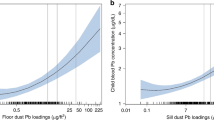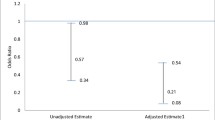Abstract
Children can be lead poisoned when leaded paint is disturbed during home renovation or repair. We conducted a case-control study to assess the association between elevated blood lead levels (BLLs) in children younger than 5 years of age and renovation or repair of homes built before 1950 in New York City. In 1998, we interviewed parents of 106 case children (BLLs)≥10 μg/dL) and 159 control children (BLLs≤5 μg/dL) living in selected New York City neighborhoods. We then used logistic regression methods to estimate odds ratios (ORs) for elevated BLLs among children living in housing that had undergone varous renovations or repairs in the 6 months before the blood lead test, and we adjusted for age and test month. Case children were only slightly more likely than control children to live in a house that had undergone any renovation (OR=1.2, 95% confidence interval [95% CI]=0.7, 2.1). Case children were more likely to (1) live in housing that had interior surfaces prepared for painting, especially by hand sanding (OR=3.5, 95% CI=1.1, 10.9; population attributable risk [PAR%]=10.4%, 95% CI=0.5% 19.3%); and (2) have work-created dust throughout their housing unit (OR =6.3, 95% CI=1.2, 32.3; PAR%=6.8%, 95% CI=0.0%, 13.1%). The risk for excess lead exposure is increased by home renovation or repair work involving interior paint preparation or reported dispersal of dust beyond the work area. The proportion of cases related to this exposure is high enough to merit preventive measures.
Similar content being viewed by others
References
Schwartz J. Low-level lead exposure and children's IQ: a meta-analysis and search for a threshold. Environ Res 1994;65:42–55.
Pocock SJ, Smith M, Baghurst P. Environmental lead and children's intelligence: a systemic review of the epidemiologic evidence. BMJ. 1994;309:1189–1197.
McMichael AJ, Baghurst PA, Wigg NR, Vimpani GV, Robertson EF, Roberts RJ. Report Pirie cohort study: environmental exposure to lead and children's abilities at the age of four years. N Engl J Med. 1988;319:468–475.
Centers for Disease Control and Prevention. Update: blood lead levels—United States, 1991–1994. MMWR Morb Mortal Wkly Rep. 1997;46:141–145.
Pirkle JL, Brody DJ, Gunter EW, et al. The decline in blood lead levels in the United States: the National Health and Nutrition Examination Survey (NHANES II-Phase 1, 1988–1991. JAMA. 1994;272:284–291.
Yiin LM, Rhoads GC, Lioy PJ. Seasonal influences on childhood lead exposure. Environ Health Perspect. 2000;108:177–182.
Clark CS, Bornschein RL, Succop P, Que Hee SS, Hammond PB, Peace B. Condition and type of housing as an indicator of potential environmental lead exposure and pediatric blood lead levels. Environ Res. 1985;38:46–53.
Lanphear BP, Matte TD, Rogers J, et al. The contribution of lead-contaminated house dust and residential soil to children's blood lead levels. A pooled analysis of 12 epidemiologic studies. Environ Res. 1998;79:51–68.
US Department of Housing and Urban Development. Current Housing Report, American Housing Survey for the United States. Washington, DC: US Depts of Commerce, Bureau of the Census, and the US Dept of Housing and Urban Development; 1995.
Rabinowitz M, Leviton A, Bellinger D. Home refinishing, lead paint, and infant blood lead levels. Am J Public Health. 1985;75:403–404.
Marino PE, Landrigan PJ, Graef J, et al. A case report of lead paint poisoning during renovation of a victorian farmhouse. Am J Public Health. 1990;80:1183–1185.
Curran JP, Nunez JR. Lead poisoning during home renovation. N Y State J Med. December 1989:679–680.
Centers for Disease Control and Prevention. Children with elevated blood lead levels attributed to home renovation and remodeling activities—New York, 1993–1994. MMWR Morb Mortal Wkly Rep. 1997;45:1120–1123.
US Environmental Protection Agency. Lead Exposure Associated with Renovation and Remodeling Activities: Wisconsin Childhood Blood Lead Study. Washington, DC: US Environmental Protection Agency; 1999. EPA 747-R-99-002.
Schlesselman JJ. Case-Control Studies: Design, Conduct, Analysis. New York: Oxford University Press; 1982:221–222.
Author information
Authors and Affiliations
Corresponding author
Rights and permissions
About this article
Cite this article
Reissman, D.B., Matte, T.D., Gurnitz, K.L. et al. Is home renovation or repair a risk factor for exposure to lead among children residing in New York City?. J Urban Health 79, 502–511 (2002). https://doi.org/10.1093/jurban/79.4.502
Published:
Issue Date:
DOI: https://doi.org/10.1093/jurban/79.4.502




